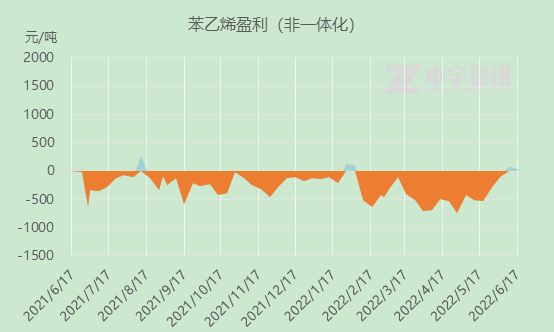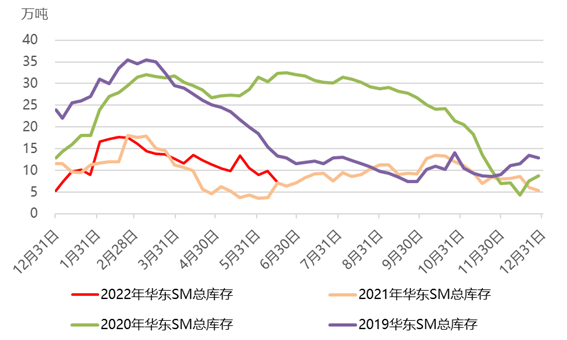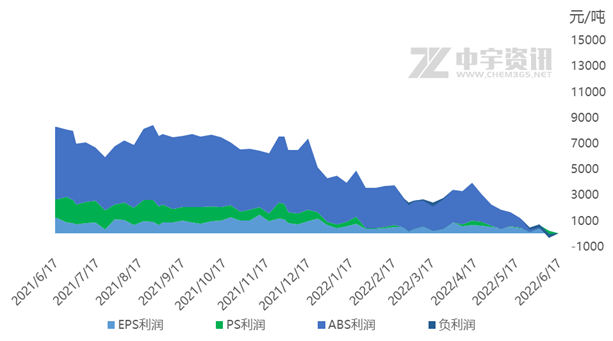В началото на юни цената на стирена се повиши с вълна от силни върхове след Фестивала на лодките-дракон, достигайки нов връх от 11 500 юана/тон за две години, освежавайки най-високата точка от 18 май миналата година, нов връх за две години. С покачването на цените на стирена, печалбите на стиреновата индустрия бяха значително възстановени, корпоративните печалби от дълбоките загуби постепенно станаха положителни, водени от вълната от високо покачване на цената на стирена, но с високия ценови натиск, енергията и чистият бензен също отбелязаха голям спад, пазарът на стирен постепенно се охлади до средата на пазара в Източен Китай обратно до 10 500 юана/тон, близо до върха, спад от около 1000 юана/тон.
Печалба от стиреновата индустрия
Както може да се види от кривата на печалбата, от миналата година маржът на печалба в стиреновата индустрия е в отрицателна територия от дълго време. Печалбата на неинтегрираните производители е по-голяма поради разходите за големия спад. Според данни, измерени в средната печалба от стирен за производство на готови продукти, средната печалба за периода януари-май тази година е -372 юана/тон. Но през юни, когато цените се повишиха, печалбите от бизнеса със стирен най-накрая станаха положителни. През първата половина на годината от началото на производството на стирен, темпът на стартиране намаля. Поради ниската рентабилност, някои външни ремонти на рафинериите бяха отложени, за да се рестартира, и сега, с подобряването на рентабилността, компаниите постепенно възобновиха производството. Темпът на стартиране на индустрията има лека тенденция на възстановяване. Общият темп на стартиране обаче е ограничен поради факта, че все още има някои ремонти на инсталации и аварии, а новият капацитет не е достатъчен за стартиране на товара.
Инвентар
Запаси от стирен в Източен Китай, към 8 юни, общите запаси от стирен в главния склад в Източен Китай (Jiangsu) са 98 500 тона, което е увеличение с 0,83 милиона тона. В сравнение с най-високите запаси през първата половина на годината, регистрирани близо до средата на февруари (177 000 тона), те са намалели със 78 500 тона или 44,3,5%. Този цикъл на запасите леко се е повишил поради високите цени, предпазливото намерение на терминала за получаване на стоки, някои обществени поръчки надолу по веригата като цяло и колебанията в темпа на работа надолу по веригата, като местното натоварване надолу по веригата леко намалява, количеството товари, отиващи към терминала, не е високо, а скорошният арбитраж в чужбина не е много оперативен и интересът от преговори за производство намалява. Намаляването на запасите може да продължи, но поради твърде високата цена, потокът от обеми е бавен.
Печалба надолу по веригата
Печалбите на трите основни низходящи EPS, PS и ABS продължават да намаляват, цените на стирена след като скочиха до над 10 000 юана, маржът на печалбата на терминала започна сериозно да се ерозира, високите разходи са трудни за конвертиране поради въздействието на крайните потребителски връзки на епидемията тази година, домакинските уреди, автомобилната и недвижимите имоти индустрията тази година е слаба, търсенето на епидемията през 1-2 тримесечия е потиснато, производителността на терминала е слаба, бизнес поръчките са намалели, след като епидемията в Източен Китай постепенно се възстанови, времето навлезе в юни, страните организирано насърчават процеса на възобновяване на работата и производството, след като епидемията е ефективно овладяна, се очаква пакет от политики за стабилизиране на икономиката да влезе в сила централно, етапът на най-голям натиск от чуждестранни смущения е преминал и започва постепенно да се успокоява, основният пазар на средносрочни ремонти е осъществен. В цялата индустриална верига, покачването на суровините е по-голямо, като близо до края на продукта способността за провеждане на цените става лоша, така че печалбите на индустриалната верига все още са небалансирани, печалбата на чист бензен е изобилна, печалбите от стирен са се поправили до положителен паричен поток, но печалбите надолу по веригата са свити, а маржовете на печалба рязко спаднаха. Поради високия натиск върху разходите, основните низходящи компании, като полистирен, постепенно губят, като в продължение на много години се поддържат високи печалби в индустрията за ABS, печалбите са свити близо до линията на разходите. Това доведе до силна съпротива от страна на някои компании надолу по веригата да намалят закупуването на суровини, а прекомерното количество суровини е потиснало крайното търсене и потребление. Очаква се индустрията като цяло да поддържа здравословна работна среда, като спадът в общите печалби надолу по веригата също оказва отрицателен натиск върху цените нагоре по веригата. Надолу по веригата, под натиска на високите разходи, пасивното регулиране на натоварването и производството на смени, както и настъпването на високи температури през лятото, също оказват отрицателно въздействие върху търсенето.
Време на публикуване: 23 юни 2022 г.







